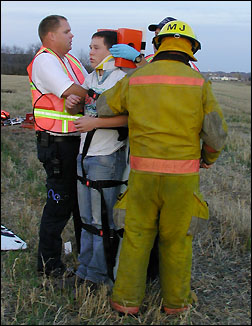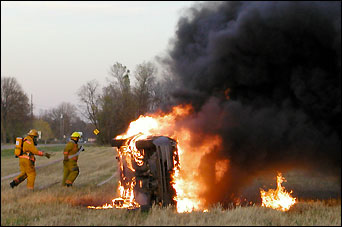Rescue workers hold joint training drill
This might be a worst-case scenario for rescue personnel, but it wasn't real, however. It was a disaster scene fabricated by the Paynesville Fire Department, to help train its fire and rescue team, as well as crews from the Paynesville Ambulance and the emergency room personnel at the Paynesville Area Hospital.
Working together, rescue workers managed to extract the bus driver and the intoxicated driver of the car- both portrayed by rescue workers - and four students (portrayed by Boy Scouts) from the wreckage last week during a training drill.
 Jeff Ruprecht, training officer the fire department and the organizer of the drill, which was staged on Cemetery Road on Monday, Oct. 20, emphasized that the drill was an important part of preparing rescue workers for the possibility of a real multi-casualty emergency.
Jeff Ruprecht, training officer the fire department and the organizer of the drill, which was staged on Cemetery Road on Monday, Oct. 20, emphasized that the drill was an important part of preparing rescue workers for the possibility of a real multi-casualty emergency.
Ruprecht was impressed with how well members of the various agencies worked together, because working together and developing good communication skills between the departments was key to the success of the excercise. "Everything wentÉas planned," he said.
"Communication is crucial when we have a multiple-casualty incident with other entities," he added, and communication between the agencies was good.
Paramedic Richard Holzer and firefighter Mike Jensen assess mock accident victim Tyler Wendroth's injuries before transporting him to the emergency room during the multi-casualty mock accident.
Ruprecht began planning the drill over two months ago when he learned that federal funds might help pay for the drill. Unfortunately, he learned later that to qualify for the funding, the drill would need to be much larger, but he felt that the community's rescue personnel still needed the exercise, because joint training with a large accident hadn't been done in several years.
Wanting the drill to be as realistic as possible, Ruprecht chose a bus accident. After securing the school bus and car from a junkyard, he recruited the Boy Scouts but didn't tell them the nature of the project so they wouldn't tell others.
Ambulance personnel portrayed the drivers of the car and the bus. Mike Noonan, who played the part of the car's driver, poured beer over himself to indicate that he was a drunk driver.
Rescue workers and emergency room personnel knew that there would be a training drill that night but were not given any details of the exercise.
Several ambulance crew members commented on how realistic the drill seemed, said Dave Schutz, the training officer for the Paynesville Area Ambulance. Schutz helped prepare the victims for their roles by drawing cuts and bruises onto their bodies and assigning each of them vital signs that would be appropriate for the type of injuries each victim had.
One teenager was given pulse, blood pressure, and respiration rates of zero to indicate that he was dead. It was important for rescue workers to encounter a dead victim to teach a valuable lesson about treating only those that they could help, said Schutz.
Bev Mueller, patient care administrator for the Paynesville Area Health Care System, and Dr. Heidi Malling, the medical officer for the Paynesville Area Ambulance and the emergency room, agreed that the drill was a valuable training tool.
 According to Mueller, emergency room personnel tried to make the drill as real as possible. They were able to treat some of the victims while others were stabalized and arrangements were made for their transfers. One nurse even found a patient's parents to get consent for a transfer.
According to Mueller, emergency room personnel tried to make the drill as real as possible. They were able to treat some of the victims while others were stabalized and arrangements were made for their transfers. One nurse even found a patient's parents to get consent for a transfer.
But, according to Mueller, something was missing in the emergency room that would have been present in a real emergency: hysteria. If it had been a real school bus accident, hysterical parents and friends would have packed the emergency room, making it difficult for staff to do their jobs.
Firefighters extinguished a car fire near the accident scene before the joint rescue drill last week between the fire department, ambulance crew, and emergency room staff.
It's difficult to duplicate working under those conditions, especially when adrenaline is abundant in staff members, she said.
A few mistakes were made during the drill, said Ruprecht, but that's what training is for, to learn from mistakes.
One problem the fire department encountered was securing the bus to make it safe for rescue workers who needed to extract victims. Firefighters on the scene discovered that there weren't enough materials on hand for such a large project.
Later discussion indicated that rescue workers learned a valuable lesson about thinking outside the box, said Ruprecht. For instance, firefighters could have asked a tow truck driver who responded to the call to help secure the bus with his truck.
Other mistakes were minor, said Schutz. "I couldn't be more pleased with the way they handled it." Schutz liked the way the separate entities worked together and apart. As the training officer, the few mistakes that were made were his own fault, Schutz added.
Within an hour-and-a-half of calling out fire and ambulance crews, the scene was secured and all of the patients were either treated or transferred to other facilities.
After all of the victims were gone, Ruprecht wanted to challenge firefighters further by starting a fire on the bus. Even though fire crews were winding down and preparing to leave, they responded to the fire quickly and had it out before Ruprecht could get it as large as he wanted, adding to Ruprecht's pleasure over a job well done.
Ruprecht would like to make joint training a regular event, pointing out that everyone involved, including the kids that portrayed the students, learned a lot. The kids, most of whom will soon be drivers, learned the consequences of drinking and driving as well as how emergency personnel respond to a disaster, according to Ruprecht.
Eventually Ruprecht would like to plan an incident that would include agencies from other communities.
While fire and ambulance crews participated in the mock accident, each unit had a response plan in effect in case there was an actual emergency. Paynesville area residents were never left without fire or ambulance services during the exercise.
Contact the author at editor@paynesvillepress.com • Return to News Menu
Home | Marketplace | Community